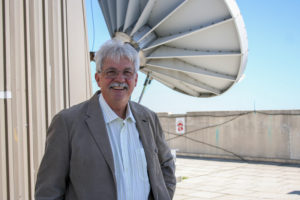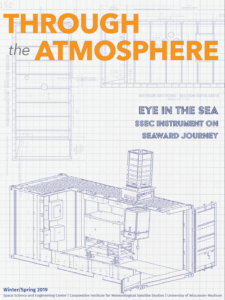Through the Atmosphere Winter/Spring 2019
 Director’s Note:
Director’s Note:
By Paul Menzel
Interim CIMSS Director
This issue of Through the Atmosphere (TtA) highlights recent news from the Space Science and Engineering Center (SSEC) and the Cooperative Institute for Meteorological Satellite Studies (CIMSS). In the last six months we welcomed SSEC’s new director, R. Bradley Pierce, listened to NOAA leadership’s vision for future R&D, conducted research to mitigate the impact of droughts on farmers, voyaged the oceans to collect ground truth observations that pair with satellite measurements of clouds and aerosols and marked the history of satellite derived soundings.
On Oct. 1, Brad Pierce began serving as Director of SSEC. He is an alumnus of the UW-Madison who brings 25-plus years of experience as a scientist at the National Oceanic and Atmospheric Administration (NOAA) and NASA to his new role. Included in this issue is a conversation with Brad in which he discusses his goals for SSEC.
During his November visit to UW-Madison, Neil Jacobs, NOAA assistant secretary of commerce for environmental observation and prediction, shared his vision for increased use of cloud computing for R&D with a common interface to facilitate collaboration. Dr. Jacobs believes that cloud computing will enable testing of a “wide funnel” of ideas and approaches thus resulting in faster development of new capabilities. He further noted the importance of machine learning and automated information extraction for obtaining full value out of satellite measurements.
In support of America’s Dairyland in Wisconsin and elsewhere, TtA reports on the work of CIMSS scientist Jason Otkin who has been conducting research on the effectiveness of the Evaporative Stress Index (ESI), which uses satellite thermal infrared imagery to estimate drought conditions. He has been talking with farmers on how to use the ESI, and other indicators, to help them prepare for drought.
TtA also introduces the SPARCLET, a downsized version of the SSEC Portable Atmospheric Research Center (SPARC), which carried the High Spectral Resolution Lidar (HSRL) on a research vessel in the Philippines this fall. Project manager Bob Holz led the team that adapted the HSRL to smaller quarters and sent graduate student Coda Phillips to help gather data that will improve our understanding of aerosols and how they interact with clouds to form convection.
We note with pride that NOAA scientist Tim Schmit has been elected a Fellow of the American Meteorological Society. This is wonderful recognition for his tireless work to improve applications, utilization and awareness of GOES data and imagery. Tim is so pervasive in his GOES outreach that he is now known as “the GOES guy.” Speaking of GOES, TtA also tracks the evolution of the sounders from leo and geo orbit, noting that the latter is still waiting for hyperspectral IR capabilities.
CIMSS is pleased to announce two new awards for 2019. The Verner E. Suomi Scholarship will be awarded to an outstanding high school senior and the William L. Smith Sr. Graduate Scholar Award to a new Ph.D. student entering the UW-Madison Department of Atmospheric and Oceanic Sciences (AOS). These awards honor the life works of Suomi and Smith, both of whom are recognized as remote sensing pioneers.
And finally, the CIMSS Board of Directors met on Dec. 5 and unanimously agreed to appoint AOS Professor Tristan L’Ecuyer as the new Director of CIMSS starting January 2019. TtA will feature him in an upcoming issue.
As these articles illustrate, SSEC and CIMSS scientists, along with their colleagues and students, continue their work to improve understanding of – and solve – our environmental challenges.

